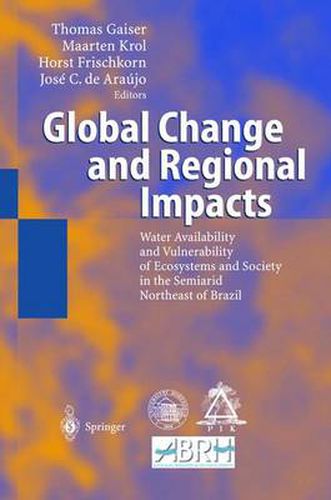Readings Newsletter
Become a Readings Member to make your shopping experience even easier.
Sign in or sign up for free!
You’re not far away from qualifying for FREE standard shipping within Australia
You’ve qualified for FREE standard shipping within Australia
The cart is loading…






This title is printed to order. This book may have been self-published. If so, we cannot guarantee the quality of the content. In the main most books will have gone through the editing process however some may not. We therefore suggest that you be aware of this before ordering this book. If in doubt check either the author or publisher’s details as we are unable to accept any returns unless they are faulty. Please contact us if you have any questions.
Global climatic change will most likely affect natural resources and human living conditions in semiarid regions. This volume presents disciplinary as well as integrative methods to assess these impacts considering the interactions between climate variability and change, water availability, land-use systems, and quality of life. Taking the semiarid northeastern area of Brazil as an example, a wide range of expertise and knowledge (from integrated water analyses to transregional migration) is necessary to understand the complex relationship between natural and socio-economic systems. Tools to integrate this knowledge and make it available for the strategic planning of sustainable development are described. This book is a summary of the main research results and the presentations given at the final conference of the WAVES Program on June 25-26 2001 in Fortaleza (Brazil). From the reviews: This book focuses on results from a joint German-Brazilian program (Water Availability and Vulnerability of Ecosystems and Society, or WAVES) to assess the socioeconomic impacts that global change will have on northeast Brazil. This book, divided into eight parts, describes the many factors that should be included in developing scenarios for future planning purposes. The book provides useful information concerning the complex multidisciplinary task of developing scenarios that can aid decision makers in formulating plans for sustainable development in an area that is highly vulnerable to climate variability and change. For someone who is unfamiliar with the semiarid northeast Brazil region, the book provides considerable useful background information.
(Vernon E. Kousky, BULLETIN OF THE AMERICAN METEORLOGICAL SOCIETY, December 2004)
$9.00 standard shipping within Australia
FREE standard shipping within Australia for orders over $100.00
Express & International shipping calculated at checkout
This title is printed to order. This book may have been self-published. If so, we cannot guarantee the quality of the content. In the main most books will have gone through the editing process however some may not. We therefore suggest that you be aware of this before ordering this book. If in doubt check either the author or publisher’s details as we are unable to accept any returns unless they are faulty. Please contact us if you have any questions.
Global climatic change will most likely affect natural resources and human living conditions in semiarid regions. This volume presents disciplinary as well as integrative methods to assess these impacts considering the interactions between climate variability and change, water availability, land-use systems, and quality of life. Taking the semiarid northeastern area of Brazil as an example, a wide range of expertise and knowledge (from integrated water analyses to transregional migration) is necessary to understand the complex relationship between natural and socio-economic systems. Tools to integrate this knowledge and make it available for the strategic planning of sustainable development are described. This book is a summary of the main research results and the presentations given at the final conference of the WAVES Program on June 25-26 2001 in Fortaleza (Brazil). From the reviews: This book focuses on results from a joint German-Brazilian program (Water Availability and Vulnerability of Ecosystems and Society, or WAVES) to assess the socioeconomic impacts that global change will have on northeast Brazil. This book, divided into eight parts, describes the many factors that should be included in developing scenarios for future planning purposes. The book provides useful information concerning the complex multidisciplinary task of developing scenarios that can aid decision makers in formulating plans for sustainable development in an area that is highly vulnerable to climate variability and change. For someone who is unfamiliar with the semiarid northeast Brazil region, the book provides considerable useful background information.
(Vernon E. Kousky, BULLETIN OF THE AMERICAN METEORLOGICAL SOCIETY, December 2004)